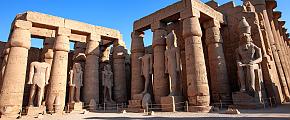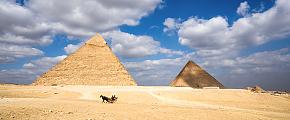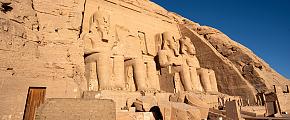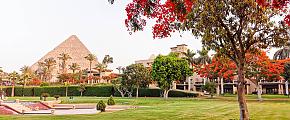Grand Egyptian Museum vs Egyptian Museum: Which to Visit
Inaugurated in 1902, the Egyptian Museum is the oldest archaeological museum in the Middle East and houses the largest collection of Pharaonic antiquities in the world. This old museum can't afford the exhibition of over 200,000 cultural relics. Therefore, the government of Egypt decided to build a bigger museum to cater to the need for the exhibition of a large number of ancient Egyptian relics, which is the Grand Egyptian Museum. But which is your next museum to visit? Grand Egyptian Museum or Egyptian Museum? Read the following articles to start your Egypt tour.
About the Grand Egyptian Museum
The design of the Grand Museum has been initiated by design studios and companies in Ireland, Germany, and Japan since 2002. The construction has been completed in nearly 10 years, and the total construction cost has exceeded 1 billion dollars. Among them, a design team of 300 people in Ireland is responsible for the design of the whole building, several design companies in Germany are responsible for the landscape, and the design team in Japan is responsible for the design supervision and construction supervision.
The Grand Egyptian Museum is now full open to the public. The huge atrium "can accommodate a Boeing 747". The architectural design of the entire museum is facing in front of the great pyramids in Egypt. The three axes of the venue radiate to the three pyramids, reflecting the millennium epic feeling of infinite time continuity.
The museum will display over 100,000 exhibits, including exhibits of famous King Tut have never been displayed before.
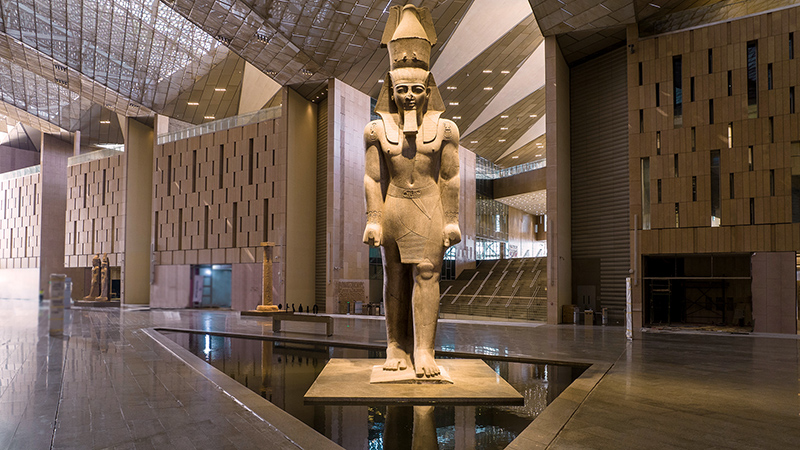 The Grand Egyptian Museum
The Grand Egyptian Museum
Must-See Highlights in the Grand Egyptian Museum
The most famous relics in the present Grand Egyptian Museum are the funeral objects of Tutankhamun. They are transferred from the old Egyptian Museum and among which, the most famous ones are as below:
1. The golden mask
The golden mask was worn by Tutankhamun after his death. The mask is commensurate with the size of the real person's face, and it just covers his face. The mask is made of gold foil and inlaid with gems and stained glass. The forehead is decorated with the eagle god and cobra god, symbolizing the upper and lower Egypt (upper Egypt uses the eagle as the protection god, and lower Egypt uses the snake as the protection god); A beard hangs below, symbolizing Osiris, the god of the underworld. This is one of the most exquisite art treasures in the world.
2. Tutankhamun's Coffin
The golden coffin of Tutankhamun is made of 450 pounds of pure gold, which is the most exquisite and greatest gold product in human history. The young King Tutankhamun died at the age of 18 and used three caskets to decorate his body. The Egyptian National Museum in Cairo has the innermost and outermost caskets. The golden coffin is made of gold and painted with exquisite carving, which has high aesthetic value.
Tutankhamun has four wooden coffins covered with gold foil, which are made of oak boards up to 6cm thick. In the old days, tomb robbers abandoned the first outer coffin when they opened it so that the human-shaped coffin placed in the outer coffin and the mummy of the pharaoh could be completely preserved. It took archaeologists 84 days to complete the demolition of the outer coffins. The four outer coffins were decorated with deities and the contents of the Book of Death, which are the most valuable materials for studying ancient Egypt.
The inner coffin is made of gold, 1.87m long, 2.5-3.5mm thick, and weighs 120kg. The coffin body is made into a human shape, which is carved with gorgeous and delicate patterns, and inlaid with colored glass, jasper, and turquoise. The front of the coffin lid shows the appearance of the pharaoh, which is similar to the shape of the gold mask. Tutankhamun crossed his hands, holding a whip and a scepter. On Tutankhamun's head, there are images of a cobra and a vulture. They are the patron saint of imperial power. Their long columnar false beard is also a symbol of imperial power.
3. Tutankhamun's Golden Throne
This gold foil-covered throne is exquisitely carved and decorated with silver, gems, and lead glass, which is regarded as an unprecedented discovery by archaeologists. On both sides of the front end of the throne are two male lions. The four legs of the chair are lion's paws. The armrests are decorated with two cobras wearing red and white crowns, guarding the royal oval emblems carved at the front end of the armrests.
The backrest is the most beautiful part of the throne, which is delicately carved with Tutankhamun sitting on the throne with a cushion. He leans on the back of the chair with his right arm, wears an elaborate wig and a special crown for celebration, wears a pleated skirt, wears a gorgeous belt, and the collar at his chest and neck is bright and colorful. He leisurely bathes in the light of the sun god. His queen Aken Esnama stood in front of Pharaoh, holding a pot of ointment to smear for Pharaoh. The crown, wig, collar, gown, and sandals showed the same luxury.
Exhibition Distribution of the Egyptian Museum
The first floor is displayed in chronological order. There are 42 exhibition halls, which display important cultural relics from the First Dynasty of ancient Egypt to the Ptolemaic Dynasty and ancient Rome.
The second floor is displayed according to the theme, with 47 exhibition halls. A large number of world-famous cultural relics are displayed, including Mummies, jewelry, coffins, paintings, and papyrus paper documents. Because the Grand Egyptian Museum has been founded and will be opened soon, most relics on the second floor have been transferred to the Grand Egyptian Museum.
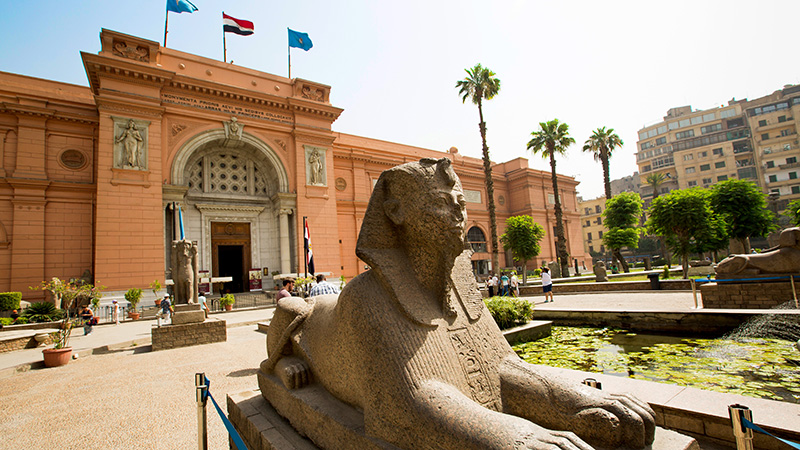 Egyptian Museum
Egyptian Museum
Must-See Highlights in the Egyptian Museum
1. Narmer Palette
It is a flat pot-shaped rock plate, 64 cm high; There is a horned ox head with a symbol of strength and majesty carved on the left and right sides of the upper part for decoration. The front and back sides are carved in the form of shallow relief, which is an independent picture of people as the main body. It is all a historical picture celebrating the founding heroes of Egypt and the first pharaoh, Menes unified Egypt in the history of ancient Egypt during the First Dynasty. In the upper part of the front, there is the giant Nalma in the middle. He wears the Egyptian crown on his head. Overlooking by the divine bird, he punishes the defeated Egyptians with his scepter, and behind him stands his waiter. The three relief pictures on the back show the victory parade ceremony. Menes put on a red crown and stood there majestically. Soldiers and soldiers passed Menes with all kinds of divine bird flags held high. Two rows of beheaded enemy corpses were neatly arranged beside the honor guard. The severed heads were placed between the legs of the dead. The picture in the middle has two crossed animal totems, which may symbolize the unification of Upper and Lower Egypt, and also indicate that after the unification of Egypt, the new dynasty was peaceful, and the people were close to each other. In the small picture below, an ox breaks through the city wall with its horn and makes the enemy flee in a hurry. It is not only a summary of the fight to unify Egypt but also a mop-up and warning to the remaining elements.
2. Statue Group of Rahoutep and Novlet
Statue Group of Rahoutep and Novlet is a sitting statue carved on two stones. Rahoutep was Khufu's brother, serving as the high priest, the commander of the three armies, and the director of construction in Heliopolis. Look at his eyes. They are made of crystal and look like dilated pupils. Take a flashlight and shine as if the shining light is staring at you.
Prince Rahoutepu was naked, wearing a white collar and a white waist skirt. His upper lip had a short beard similar to that of a modern Arab man, and his skin was dark. Novlet looked dignified, with black hair reaching to his shoulders, a white colored flower hair band on his forehead, and a necklace painted in black, blue, and red on his neck. His plump body looked graceful and moving in the white dress. This group of sitting figures is also representative of the distinctive distinction between the color of men's skin and women's skin in ancient Egyptian art. The brown man and white woman represent the aesthetic taste at that time.
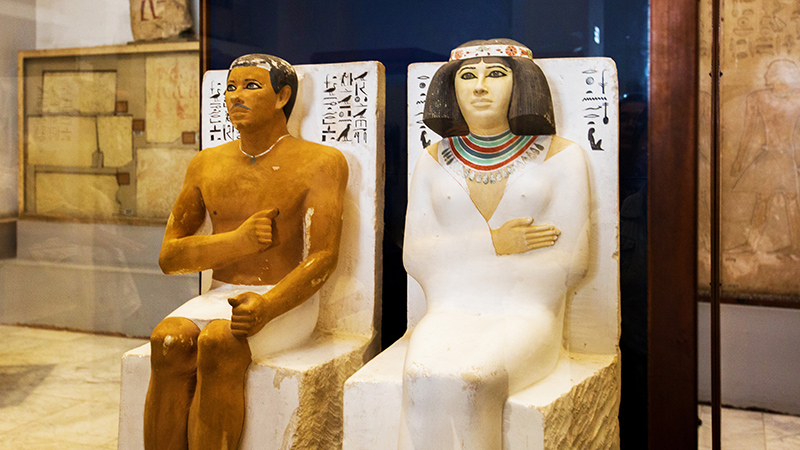 Statue Group of Rahoutep and Novlet
Statue Group of Rahoutep and Novlet
3. Statue of King Monkara
The Statue of King Monkara consists of three statues. The pharaoh stood solemnly in the middle, and the goddess Hathor was on the right, often in the form of a sun disk and an ox horn crown. Both women wore tight long skirts, showing their plump physiques, in contrast to Pharaoh's strong body. Pharaoh wears the white crown of Egypt and has a columnar beard under his jaw, which are typical symbols of divine power. Like other parts of the statue, the pharaoh's round face was polished and almost completely smooth, thanks to the use of non-particularly hard stones by the craftsmen, so the expression can be gently treated. Mongkara's solemn expression is very similar to that of the two women beside him, but the two women are shorter than the pharaoh, which reflects the adherence to hierarchy.
The Egyptian Museum is the ancient Egyptian history museum in Cairo, the capital of Egypt. It has more than 120,000 ancient Egyptian historical relics in its collection, including a large number of cultural relics from the reign of the first dynasty of ancient Egypt to the reign of Ptolemy, the last ruling dynasty of ancient Egypt. Founded in 1901, the museum was designed by French designer Marcel Dolgoron and has been exhibited for more than 100 years. Therefore, it is a must-choose attraction for tourists from all over the world to take a tour to Egypt.
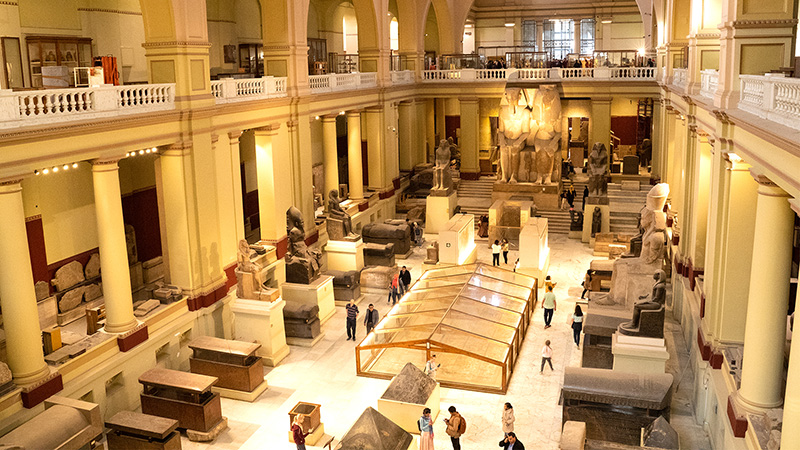 Egyptian Museum
Egyptian Museum
At last, if you are very fond of the culture of ancient Egypt and also have a special yearning for the mysterious legends of ancient Egypt. The Egyptian Museum is definitely one of the important tourist attractions that you can't miss when visiting Egypt. If you are planning to take an Egypt trip but don't know how to start, please don't hesitate to contact us, just simply tell us your interests and needs, and one of our travel experts will create a tailor-made itinerary for you within 24hrs.

